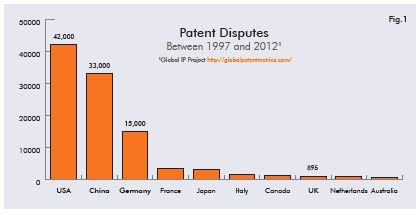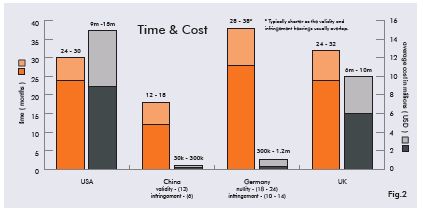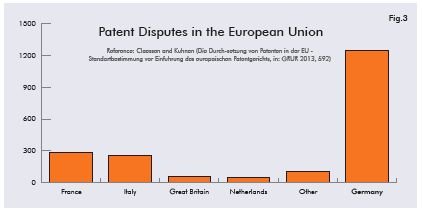Professional third-party funders tend to stay away from patent disputes. It is unfortunate because this is an area where SMEs and individual inventors whose only assets are often their ingenuity need help. This is a category of claimant that is arguably most in need and deserving of the assistance provided by professional third-party funders.
But the reality is that patent disputes are tricky - often not because of the dispute but because of the process. Patent disputes have a reputation for being expensive, slow and worst of all, unpredictable. What seems like a solid dispute can be ruined by the sudden appearance of prior art (ie where a defendant can identify that the method or process protected by the patent was in the public domain before the patent was applied for). Expensive, slow and unpredictable means that from a funding perspective, patent disputes are tough to fund. But not all jurisdictions are equal, as we know. As we did for electricity disputes in the previous issue, to assess the risk we must ask the questions – who wins, where and why?
As explained below, the answers to these questions identify Germany as a hotspot for patent disputes offering higher win rates than either the UK or the US and the third-largest market for IP disputes in the world. Professional third-party funders need not fear the process: IP claims in Germany are a massive growth area. This is good for patent holders, good for law firms and good for funders.
The Market
The sheer volume of patent disputes globally means that as a market for potential legal fees, investment opportunities and damages, patent disputes are enormous. There were approximately 90,000 patent disputes over 15 years across the top three IP jurisdictions and the UK (Fig. 1). From a funder's perspective, that's a market size of approximately 6,000 disputes per year. However, before measuring risk (ie impact vs probability) claimants and funders must first consider the time, cost, quality triangle.

Time, Cost, Quality
Claimants and funders alike, regardless of jurisdiction, want to know the answer to four basic questions when considering whether to invest in a patent dispute:
- How long will it take?
- How much will it cost?
- How strong is our case?
- What will we get?
As Microsoft's former vice president of intellectual property and general IP guru Marshall Phelps has said, business managers do not like a 'random walk through life'. These are the types of high-level tactical questions that allowed Phelps to implement a strategy that took IBM from a few million dollars in IP-related revenues in the late 1980s to over a billion dollars in a little over a decade. These questions are essential for every patent claimant and every funder considering investing in a patent dispute. Patent disputes, like most modern commercial disputes, are not just about the dispensation of justice. They are about the compensation of loss. Accordingly, time and cost are essential variables in the assessment of a claim's prospects of success. These factors are just as important for funders as they are for claimants.
Which jurisdiction is faster (time), cheaper (cost) and fairer (quality), are the three components of the time, cost, quality triangle. With the extensive information available on patent disputes from studies such as the Global IP Project, it is apparent that not all jurisdictions are equal from a claimant's, or indeed, a funder's point of view.
Project managers, far more than lawyers, are familiar with the time, cost, quality triangle: the basic premise being that you can only ever have two at the expense of the third. A process might be fast and cheap, but it will suffer in quality. Or a process might be good and fast, but it will suffer in cost. Accordingly, we can measure our four jurisdictions in reference to the time, cost, quality triangle to determine which jurisdiction is best for patent claimants and, accordingly, funders. Perfection would look like this: 0 months, 0 costs, 100% of claim. It is the platonic ideal, useful in practical terms only as a yard stick to measure the actual results.
Time and cost can be readily assessed - simple metrics compared on a simple chart (see Fig.2)

These sorts of charts are necessarily rounded. Outliers undoubtedly exist in each jurisdiction in respect to time and cost, but they need not spoil the analysis. For instance, in the US there are notable differences between states. In Virginia, the time to trial averages less than 20 months, whereas patent disputes in Illinois average nearly 60 months to trial. But when these outliers are stripped out, the average time taken is 30 months. Similarly, costs can be much higher or much lower. In some jurisdictions, such as China and Germany, the amount in dispute determines, within a defined band, the court costs. Similarly, legal fees tend to increase with the value in dispute even if complexity does not increase. Accordingly, for the purposes of assessing costs, the above chart generally considers quantum levels measurable in the US$ 10s of millions.
A more difficult analysis, however, is quality. Time and costs are quantitative assessments for which data is readily available, as demonstrated above. Qualitative assessments necessarily require consideration of less quantifiable factors such as legal representation, judicial capacity and capability, and legal process. These are factors that do not lend themselves easily to measurement. For instance, in the US and the UK there is extensive disclosure/ discovery.
This has a detrimental impact on time and cost but can anyone argue that it is not a more thorough process because of it? China is seemingly faster and cheaper, but, without a process of disclosure, are key facts being overlooked? Germany and China have bifurcated systems, separating validity from infringement. How does this compare to the US and UK processes where validity and infringement are entwined? In China and Germany, you have specialist and technically trained judges, whereas in the US there is a constitutional right for either side to insist on trial by jury. In each of these jurisdictions what is the role of experts?
In the US and the UK, experts can often be the most expensive single disbursement and can be decisive in determining who wins. in contrast, in Germany, specialist courts and technically trained judges, in validity proceedings in particular, seldom require experts and when they do, they are generally appointed by the court. These are all qualitative factors that patent lawyers in a global economy weigh carefully when considering their dispute strategy.
But what really matters when we are considering these qualitative nuances? It is what Phelps determined 'walkers through life' expect: the win rates. Who's winning in these jurisdictions regardless of their peccadillos and peculiarities? 'Who wins?' is the question we pose when jurisdictions are qualitatively assessed. Is a claimant more likely to win in Germany or the UK? In the US or China? Thanks to research like that conducted by the Global IP Project, we have the raw data that at least provides some quantitative support for this qualitative assessment.
Win Rates
In comparison to the platonic ideal of the time, cost, quality triangle for patent disputes, China is the fastest and the cheapest of the top three IP disputes jurisdictions. However, we know that in China disclosure is non-existent and its patent disputes are handled in ordinary civil courts. Furthermore, and according to Ms Shen of the Beijing Sanyou Intellectual Property Agency Ltd, damage awards tend to be lower in China than in other jurisdictions.
| Country | Win Rates |
| China | For invention patents 66% of claimants win on infringement but only 57% win in validity proceedings. For design patents, claimants win 85% of infringement proceedings but only 42% clear validity proceedings. Similarly, although claimants for utility models win 72% of infringement proceedings, only 46% pass the validity proceedings. |
| Germany | Overall patentee win rates (in Dusseldorf) for infringement proceedings is 60-66% (533 of the 811 decisions between 2009 - 2013) However, like China that is only for those who succeed in validity proceedings (38%). |
| UK | Overall patentee win rate of 27% (35 out of 129 decisions where infringement/validity were in dispute between 2009 - 2013) |
| US | 59% overall; 25% 'contested'; PI win rate 31%; 47% in US ITC |
In any event, from a funding perspective, as China still does not allow third-party funding the jurisdiction is off limits - for now (as with Singapore, Hong Kong is reconsidering its position on champerty and maintenance). In contrast, the US system is by far the most expensive in terms of costs, but damages are potentially extremely high as claimants may be entitled not only to compensatory damages (i.e. reasonable royalty) but also enhanced damages for wilful infringement.
Meanwhile, the UK offers a seemingly excellent jurisdiction for wealthy defendants, having high costs, long durations and low win rates. Which, of course, leaves Germany: patent disputes for claimants in Germany are cheaper than in the US and the UK with win rates similar to those found in China.
Germany, the undiscovered country
From a funder's perspective, Germany may well be the undiscovered country. It is a particularly interesting jurisdiction for foreign patent holders. Parties based abroad are involved in approximately half of the patent infringement actions in Germany. Of the 2,043 patent infringement cases across the five main jurisdictions in Europe for patent disputes last year, Germany accounts for over 90% of them.
The separation principle stipulates that questions of infringement and validity of the proprietary rights are answered by different authorities. In Germany, the district courts have the jurisdiction for infringement issues at the first instance. This means that, unlike in most other jurisdictions, a defendant cannot mount a defence on the grounds that the patent which is the basis of the claim made against it is invalid or should be declared invalid.
According to Daniel Hoppe-Jaenisch of white & Case, Hamburg, Germany, bifurcation is a relatively unique feature of German patent infringement law in comparison with most jurisdictions. Germany is very popular amongst plaintiffs because it allows for a swift enforcement of patents. Defendants fear bifurcation and fight it because the principle bears the risk that the court might find against them based on a non-valid proprietary right, and thus they may suffer significant damages. In this way, Germany appears very clearly to be a pro-claimant jurisdiction for patent disputes.

Do the maths
The Global IP Project has worked up a formula that appears to be a recipe for success for claimants and a method to assess this decorrelated asset class for funders.
Plugging in the metrics extracted from the time, cost, quality assessment above into this formula reveals a simple conclusion. Among the jurisdictions where third-party funding is permitted, far more patent disputes are likely to be successful, with significant damages and less cost, in Germany than in any other jurisdiction: but only in respect of infringement proceedings. The high bar remains for validity. But here too, Germany's bifurcated system offers more certainty in respect of time and cost. This is good news for claimants and their funders.
| Expected Value ( EV ) = Win Rate x ( A+B+C) - Lose Rate x (D+E) - F | |
| Win Rate | Probability Patentee Will Win |
| A | Expected Value of Past Damages Award |
| B | Expected Value of Future Remedy |
| C | Expected Value of Reimbursed Litigation Costs |
| Lose Rate | Probability Patentee Will Lose |
| D | Expected Value of Lost Licensing Revenues |
| E | Expected Value of Reimbursing Opposing Party Costs |
| F | Costs of Going to Trial |
Patent disputes: what the experts say
UK
The English Court system is often thought as being a
high-cost forum for patent litigation that is prohibitively
expensive for all but the deepest pockets. In fact, over recent
years (and especially since completion of its reform in 2013) the
Intellectual Property Enterprise Court ("IPEC") has
established itself as providing a relatively quick and low-cost
alternative to proceedings in the Patents Court. However, even with
the streamlined procedures of IPEC, many potential claimants find
that the time and cost of protecting their patents through the
Patents Court puts access to justice beyond their reach. This,
of course, is where third party funding can bridge the gap
and allow meritorious claims, that would otherwise flounder, to
proceed.
John Runeckles, counsel, Jenner & Block, London
France
Patent litigation in France is advantageous in many
respects. The well-known French
"saisie-contrefaçon" is a very efficient tool to
gather evidence of the materiality, the origin and the scope of the
infringement. The system is not bifurcated meaning that
infringement and validity are litigated in one single procedure,
which proves efficient and leads to balanced decisions. Litigating
in France is more affordable than in other jurisdictions and the
winning party is usually awarded a reasonable amount for the
reimbursement of its legal fees. Finally, damages which are often
assessed within the scope of a judicial expertise can be
substantial.
Anne-Charlotte Le Bihan, partner, Bird & Bird
USA
While new patent infringement filings have declined for the
first time in many years, this may be a temporary transition as the
US patent system recalibrates. We have found that increased
attention to such changes permit for reasonable predictability in
the enforcement and defense of patents. Clients have also been more
open to financing enforcement efforts as a way of adding
predictability to their budgets. The overall acceleration of key
decision making, such as to claim construction and validity, can be
useful in early resolution and settlement of disputes where the
early decision is applicable in later proceedings.
Eley O. Thompson, partner, Foley & Lardner,
Chicago
Netherlands
In the Netherlands, patent owners are able to quickly obtain
a well-reasoned (final relief) decision on the merits of the case
(on both infringement and validity) from a specialised and very
experienced patent court. Costs of proceedings on the merits (first
instance) tend to range from about €75,000 for relatively
simple mechanical cases to € 500,000 (and occasionally higher)
for very complex pharmaceutical or high-tech/telecoms cases. The
winning party in patent enforcement action is entitled to claim
compensation of its costs, including lawyers' costs. The cost
involved in patent litigation in the Netherlands is quite
reasonable, especially compared with the UK or the US, inter alia
due to the fact that Dutch procedure does not provide for
disclosure/discovery proceedings. The lack of disclosure/discovery
proceedings means that the case is limited to what parties decide
to put forward, which enables parties to keep focus on the most
important aspects of the case, thus preventing the volume of the
work to be invested from spiralling out of control.
Jaap J.E. Bremer, attorney at law, BarentsKrans, The
Hague
Germany
Germany is of huge importance as a jurisdiction for patent
litigation in Europe. Year after year, a large number of patent
infringement actions are brought in Germany. The German judiciary
offers patent holders exceptionally good chances to successfully
enforce their proprietary rights. Hence the German patent
infringement litigation is of considerable interest for companies
around the world. Vannin is my first choice for third party funding
of strong claims that otherwise might not proceed to litigation.
Vannin's process is very efficient and timely. The experience
has been very positive and based on that I have recommended third
party funding to other claimants. I consider Germany the European
leader for patent disputes and owing to the strengths of the German
system, here I would have thought funders would be keen to support
meritorious claims in the region.
Daniel Hoppe-Jaenisch, partner, White & Case,
Hamburg
Italy
Italy is one of Europe's largest jurisdictions for
patent disputes and one of its major economies. Despite costs being
far more reasonable in Italy than in other European jurisdictions
and though its system offers a very effective implementation of
interim remedies such as ex parte search order, seizure of
infringing goods also against third parties or publication of
orders and judgments often patent infringements go unchallenged.
With liquidity being a very precious asset, in particular for
domestic companies, frequently patent holders prefer not to invest
the time and the costs involved in pursuing a claim. Infringement
of claims of foreign patent holders often are not pursued due to
lack of familiarity with the particulars of the Italian system.
Third-party funding may significantly lower the involved risks and
offer a solution not only to those for whom time and cost are
impediments but also to patent holders who still gain first
experiences in foreign jurisdictions.
Tankred Thiem, head of German desk, LGV Avvocati,
Milan
China
"Why China? Five reasons: 1. Large Market (1.4 billion
people); 2. Huge number of valid patents (over 3.5 million patents
including over 1.098 million invention patents); 3. Quick –
first instance, normally within one year and second instance, even
quicker; 4. Stronger weight in negotiations; and 5. Inexpensive
– first instance attorney fee is normally in the US$30,000
– US$300,000."
Lena Shen, partner, Beijing Sanyou Intellectual Property
Agency, China
Originally published in Funding In Focus, November 2015
The content of this article is intended to provide a general guide to the subject matter. Specialist advice should be sought about your specific circumstances.
